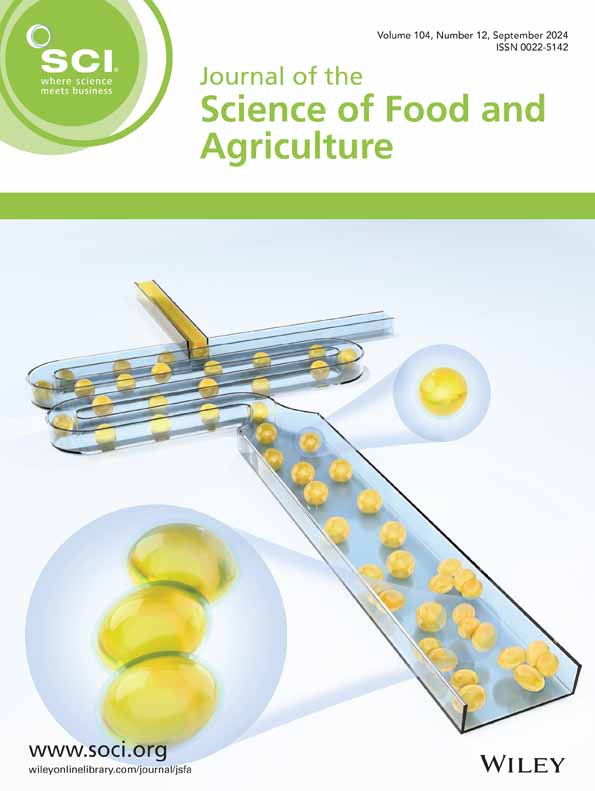Dhiraj Kumar Yadav, Santanu Malakar, Sanjana Kumari, Krantidip Pawar, Sanket Balasaheb Kokane, Shweta Suri, Vinkel Kumar Arora
求助PDF
{"title":"超声处理对小米质量的影响及其意义综述。","authors":"Dhiraj Kumar Yadav, Santanu Malakar, Sanjana Kumari, Krantidip Pawar, Sanket Balasaheb Kokane, Shweta Suri, Vinkel Kumar Arora","doi":"10.1002/jsfa.14349","DOIUrl":null,"url":null,"abstract":"<p><p>Millets are nutritious small-seeded grains that have the potential to help address hidden hunger while also meeting the increasing food demand. The use of ultrasound technology in millet processing has become a highly effective tool that surpasses traditional thermal processing techniques. This review article examines the potential of ultrasound treatment in decreasing antinutrient levels, altering starch and protein functionality, and extracting the bioactive compounds from millets. Recent research offers compelling proof that using ultrasound on millet caused substantial changes in its polyphenolic content and antioxidant properties. The level of enhancement in antioxidant properties greatly relies on factors such as intensity, duration, and frequency of ultrasound and the composition of the food matrix. Furthermore, ultrasound processing affected the amorphous region and had no significant impact on the crystalline region of millet starch granules. However, at elevated temperatures, ultrasound improved the crystallinity of starch. Ultrasound treatment led to starch molecule agglomeration, enhanced gelatinization, and functional attributes of millet starch. The ultrasound treatment causes an enhancement in millet protein solubility, surface hydrophobicity, and emulsifying and foaming properties. Furthermore, the characteristics of the fiber in millet are enhanced through ultrasonic treatment. In general, ultrasound processing has potential for enhancing millet functionalities in the food sector. © 2025 Society of Chemical Industry.</p>","PeriodicalId":17725,"journal":{"name":"Journal of the Science of Food and Agriculture","volume":" ","pages":""},"PeriodicalIF":3.3000,"publicationDate":"2025-05-12","publicationTypes":"Journal Article","fieldsOfStudy":null,"isOpenAccess":false,"openAccessPdf":"","citationCount":"0","resultStr":"{\"title\":\"Impact of ultrasound treatment on millets - quality assessment and implications: a review.\",\"authors\":\"Dhiraj Kumar Yadav, Santanu Malakar, Sanjana Kumari, Krantidip Pawar, Sanket Balasaheb Kokane, Shweta Suri, Vinkel Kumar Arora\",\"doi\":\"10.1002/jsfa.14349\",\"DOIUrl\":null,\"url\":null,\"abstract\":\"<p><p>Millets are nutritious small-seeded grains that have the potential to help address hidden hunger while also meeting the increasing food demand. The use of ultrasound technology in millet processing has become a highly effective tool that surpasses traditional thermal processing techniques. This review article examines the potential of ultrasound treatment in decreasing antinutrient levels, altering starch and protein functionality, and extracting the bioactive compounds from millets. Recent research offers compelling proof that using ultrasound on millet caused substantial changes in its polyphenolic content and antioxidant properties. The level of enhancement in antioxidant properties greatly relies on factors such as intensity, duration, and frequency of ultrasound and the composition of the food matrix. Furthermore, ultrasound processing affected the amorphous region and had no significant impact on the crystalline region of millet starch granules. However, at elevated temperatures, ultrasound improved the crystallinity of starch. Ultrasound treatment led to starch molecule agglomeration, enhanced gelatinization, and functional attributes of millet starch. The ultrasound treatment causes an enhancement in millet protein solubility, surface hydrophobicity, and emulsifying and foaming properties. Furthermore, the characteristics of the fiber in millet are enhanced through ultrasonic treatment. In general, ultrasound processing has potential for enhancing millet functionalities in the food sector. © 2025 Society of Chemical Industry.</p>\",\"PeriodicalId\":17725,\"journal\":{\"name\":\"Journal of the Science of Food and Agriculture\",\"volume\":\" \",\"pages\":\"\"},\"PeriodicalIF\":3.3000,\"publicationDate\":\"2025-05-12\",\"publicationTypes\":\"Journal Article\",\"fieldsOfStudy\":null,\"isOpenAccess\":false,\"openAccessPdf\":\"\",\"citationCount\":\"0\",\"resultStr\":null,\"platform\":\"Semanticscholar\",\"paperid\":null,\"PeriodicalName\":\"Journal of the Science of Food and Agriculture\",\"FirstCategoryId\":\"97\",\"ListUrlMain\":\"https://doi.org/10.1002/jsfa.14349\",\"RegionNum\":2,\"RegionCategory\":\"农林科学\",\"ArticlePicture\":[],\"TitleCN\":null,\"AbstractTextCN\":null,\"PMCID\":null,\"EPubDate\":\"\",\"PubModel\":\"\",\"JCR\":\"Q1\",\"JCRName\":\"AGRICULTURE, MULTIDISCIPLINARY\",\"Score\":null,\"Total\":0}","platform":"Semanticscholar","paperid":null,"PeriodicalName":"Journal of the Science of Food and Agriculture","FirstCategoryId":"97","ListUrlMain":"https://doi.org/10.1002/jsfa.14349","RegionNum":2,"RegionCategory":"农林科学","ArticlePicture":[],"TitleCN":null,"AbstractTextCN":null,"PMCID":null,"EPubDate":"","PubModel":"","JCR":"Q1","JCRName":"AGRICULTURE, MULTIDISCIPLINARY","Score":null,"Total":0}
引用次数: 0
引用
批量引用

 求助内容:
求助内容: 应助结果提醒方式:
应助结果提醒方式:


